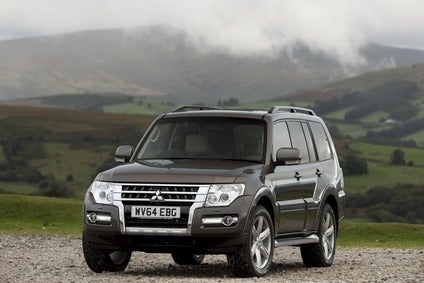
The Discovery will be 11 this year, but one of its rivals is older still. Launched in Japan more than 15 years ago, Mitsubishi’s biggest SUV has had yet another facelift.
MMC might be profitable now, but this is a recent thing. Years of heavy losses saw its main shareholders – other Mitsubishi Group companies – injecting much cash and insisting on cost cuts. That meant extensive delays to quite a few vehicle replacement programmes, which is why what we in Britain call the Shogun has become so aged.

Discover B2B Marketing That Performs
Combine business intelligence and editorial excellence to reach engaged professionals across 36 leading media platforms.
The current model seems likely to be around for a further three years as the priority is to invest funds in replacements for potentially higher volume models. That includes the Lancer, which will likely be based on the next Renault Fluence and is being co-developed by Nissan Motor and Renault Samsung. By the time it arrives in late 2016, the seventh generation Lancer will have been in production for a decade. RSM will also be the source of a long overdue successor to the Galant, which will be built in South Korea for the US and Canadian markets.
A replacement for the tiny i-MiEV electric hatchback is also due to arrive before the fifth generation Pajero/Shogun. This future small hatchback is part of NMKV, the Japan-based venture between MMC and Nissan Motor. There will also be a variant with a combustion engine and these four models will be sold in multiple countries, both firms stated in November 2013.
MMC believes that much of its future expansion depends on certain markets in Asia, and doesn’t just mean China. Four months ago, company CEO Osamu Masuko said construction of a US$600m factory in Jakarta’s satellite city Bekasi would commence this May. The plant will bring the carmaker’s overall Indonesian production capacity to 240,000 units per year by the time of completion in 2017. A purpose-designed MPV will be built there, and also exported to neighbouring ASEAN markets, including The Philippines, Thailand and Vietnam. Meanwhile, Thailand is the firm’s existing big regional production hub and its latest new product, a new generation L200/Triton pick-up, will soon be available in the UK and other parts of Europe.
Mitsubishi has lately been doing far better in EU markets than was the case in the half decade which followed the beginning of the Great Recession. SUVs and crossovers have been key to this new-found success, with the ASX, Outlander and more recently, the Outlander PHEV being the main reasons. Still, and despite its advanced years, the Shogun has played a not insignificant role in the comeback, particularly in the UK. It’s sold as the Pajero in most other markets, with the exception of Spanish-speaking ones where it’s known as the Montero.
Looking at registrations for the year to the end of November (ACEA is yet to release full-year numbers), Mitsubishi has sold an impressive 93,518 passenger vehicles, a YoY surge of 32.1% against an overall 5.5% gain for these 30 markets. Another 175 cars and it would have outperformed Honda. Presuming December was as good as November, when sales were up by 10.5% to 8,846, Mitsubishi could get close to having a 1.0% market share. For the 1 January-30 November period, it was 0.8%, compared to 0.6% for the first eleven months of 2013.
European buyers have made the region the top market worldwide for this big 4×4. The most recent figures show 5,892 units were sold up to the end of November 2014, which was up 29% year on year. In the UK, the model’s performance has been even better, with YoY registrations having surged by 70% after a big price cut was announced.
UK market share for the brand reached 0.64% in 2014, the SMMT’s data shows. That meant a YoY rise of 75%, and 79% for December alone, when 1,362 vehicles were registered here. The annual tally of 15,805 compares to just 9,044 and market share of 0.4% in CY2013.
The L200, Mirage, ASX, Outlander and Outlander PHEV have all been selling well, as has the Shogun and the addition of a five-year warranty for all models will no doubt help matters even more. This was announced just a few days ago and took effect from 1 January.
I last reviewed this big SUV in September 2013 so I won’t repeat my findings from that time, and instead will just note what’s changed since then. Pricing has been further revised and there is more standard equipment for the 2015 model year. The newly facelifted range now starts at GBP26,199 (short wheelbase/3dr SG2 manual) and rises to GBP36,799 (LWB/5dr SG4 auto). You can tow up to 3,000kg in the SWB variants and a further half a tonne in the long wheelbase ones.
There is a fresh audio system, improved sound deadening on all automatics (it’s the same five-speed gearbox, though) and the standard 3.2-litre diesel engine has better Combined MPG averages of 36.2 (three-door) and 33.2 (five-door). Emissions remain at 213g/km for manuals and 224g/km for automatics.
Mitsubishi has found the better MPG numbers by, it claims, a lower idling speed and a new alternator which draws less power. All useful refinements and the vehicle itself doesn’t feel too much like something from yesteryear, despite having first landed on these shores a decade and a half ago. Can it remain competitive until the fifth generation Pajero/Shogun/Montero appears? Probably, but when will be?
Mitsubishi gave an outline of the thinking behind the next model when it displayed a design study for a large plug-in hybrid SUV at the Tokyo motor show in November 2013. This was called Concept GC-PHEV (‘Grand Cruiser’) and featured a supercharged V6 petrol engine. I would expect to see a further evolution at the next Tokyo show towards the end of this year and then a production model at the 2017 edition of this event. A PHEV variant is considered a near-certainty and would be aimed largely at the US and European markets. The way the Outlander plug-in hybrid is selling, Mitsubishi could by then be the name in SUVs with PHEV powertrains.






